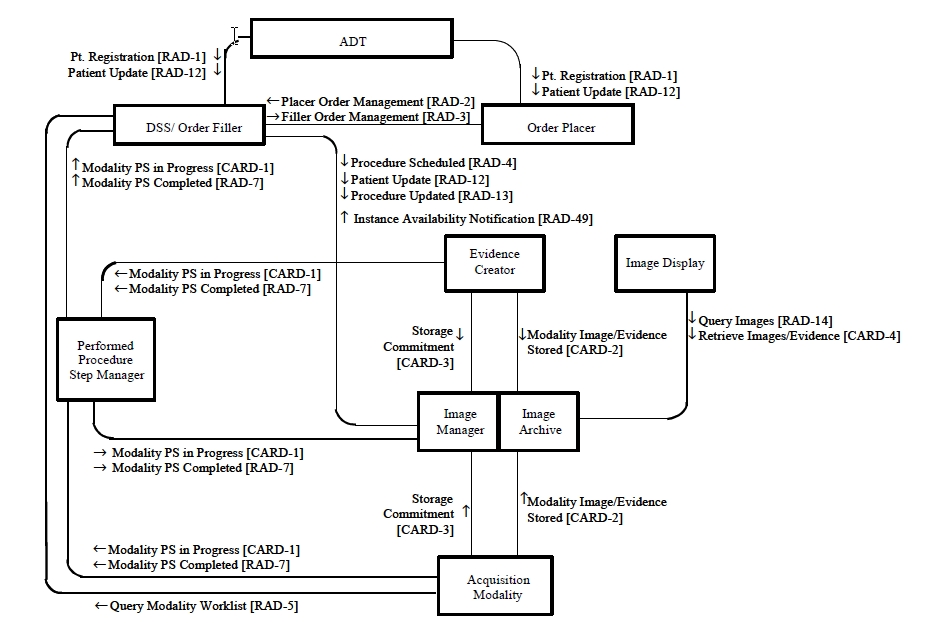Echocardiography Workflow
This integration profile integrates ordering, scheduling, imaging acquisition, storage and viewing for digital echocardiography
Summary
The Echocardiography Workflow Integration Profile describes the workflow associated with digital echocardiography, specifically that of transthoracic echo (TTE), transesophageal echo (TEE), and stress echo. As does the Cath Workflow Integration Profile, this profile deals with patient identifiers, orders, scheduling, status reporting, multi-stage exams (especially stress echo), and data storage. It also specifically addresses the issues of acquisition modality devices that are only intermittently connected to the network, such as portable echo machines, and addresses echo-specific data requirements.
The Echo workflow is focused on the imaging acquisition process, and image-based measurements made either on the modality or on an independent workstation. Items not included would be nursing notes, drug administration documentation, etc. The TEE, TTE, and stress echo workflows are treated identically for the purposes of workflow control.
Benefits
Cardiologists
Patient care is improved and cardiologists’ time is saved by:
- Allowing immediate patient care to be the priority, knowing the system will help manage the ordering and accounting on the back end
- Ensuring that images are created with proper identifiers so that image display is consistent, especially for stress echoCardiologists Patient care is improved and cardiologists’ time is saved
- Allowing immediate patient care to be the priority, knowing the system will help manage the ordering and accounting on the back end
- Ensuring that images are created with proper identifiers so that image display is consistent, especially for stress echo Providing echo measurement interoperability – complete the preliminary echo measurements on the cart and transfer as structured data to the reporting workstation for the final report
- Reducing the need for duplicate procedures
- Reducing delays in charge posting due to improper orders
- Ensuring images and measurements are securely stored
- Uploading echo reports to the hospital or office information system
Cardiology Administrators and Technologists
Echo lab workflow is improved and time is saved by:
- Automatically obtaining correct patient demographics and procedure code information
- Automatically correcting demographics in cases such as patient identification not obtained in advance (reduces the need of personnel to “fix” studies and data)
- Accurately identifying data to facilitate easier data collection later (e.g., disease registries or outcomes analysis)
- Improving the handling of ad hoc echo procedures which might otherwise not get billed due to insufficient or inaccurate information
- Assisting in maintaining the statuses of procedures in real-time for better lab management
- Verifying that all images obtained, even on mobile systems, are securely archived prior to deletion
Cardiology IT Staff
Other IT projects can come to fruition when time is saved in the echo lab by:
- Reducing or eliminating “interface projects”, including specification and testing
- More stable and robust interfaces, including during system upgrades
- Ensuring that a multi-vendor environment will function correctly
- Reduction of “switching costs” when a new system is purchased, including time to configure new ultrasound modalities
- Managing and simplifying RFP’s and purchases by using IHE-specified connectivity profiles
- Selection of the “best solutions” from multiple vendors and reduction of vendor integration issues, eliminating the need for a single vendor all-encompassing solution
Patient
The patient also benefits from systems integration in the cath lab by:
- Removing the need to wait while demographics are entered into the various cath lab systems and old reports are pulled.
- Enabling better patient care because the interpreting physician can more accurately assess interim changes.
- Providing cath reports more readily to other care team members within and outside a hospital or office network.
Details
The Echocardiography Workflow (Echo) Integration Profile:
- Establishes the continuity and integrity of basic departmental imaging data by profiling specific usage of HL7 messaging across multiple systems including: Patient registration (ADT), Order Placing (CPOE) and Order SCheduling (RIS) systems.
- Bridges the gap between HL7-based systems (like RIS) and DICOM-based systems (like acquisition modalities and PACS) within the radiology department by specifying the semantic mappings between messages.
- Maintains the consistency of patient demographic and ordering information across multiple systems by making that information available to image acquisition modalities via the DICOM Modality Worklist (MWL) Service.
- Ensures that acquired images are not inadvertently lost by specifying that the DICOM Storage Commitment Service is used to transfer the custodianship of images from the modality to the PACS.
- Ensures that the status of acquisition workflow steps are known throughout the department by specifying the use of the DICOM Modality Performed Procedure Step (MPPS) Service to convey that status from the modality to the RIS and the PACS.
Systems Affected
Systems involved in this profile are:
- Enterprise-wide information systems that manage patient registration and services ordering (i.e., admit-discharge-transfer (ADT)/registration system and hospital information system (HIS ))
- Cardiology information systems that manage department scheduling
- Image management/archiving systems (i.e., picture archiving and communication system (PACS))
- Acquisition modalities
Actors & Transactions:
Specification
Profile Status: Final Text
Documents:
IHE Cardiology Technical Framework:
Underlying Standards:
See Also
Related Profiles
Consumer Information
Implementer Information
Reference Articles
This page is based on the Profile Template

